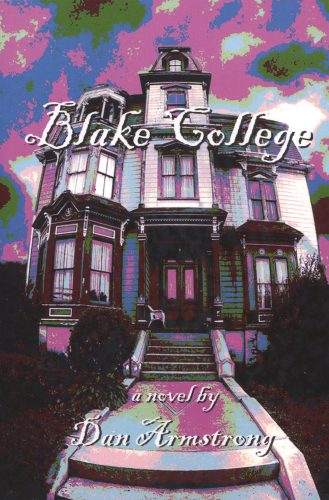
Blake College by Dan Armstrong. Mud City Press, $15.
I arrived in Eugene from New York in 1988. On a warm September evening a few weeks later, one of my new colleagues at the Univesity of Oregon took me out on what he said was an essential tour of the town. First, we went to Luckey’s on Olive Street. Some readers might remember what Luckey’s was like 30 years ago: a thick haze of cigar smoke, a line of men — all men — standing at the bar, a cloudy back room with pool tables, all of it in a rumbling roar. We lit up cigars, but didn’t stay for a second drink. Instead we headed to Max’s Tavern on 13th Avenue for a different vibe: less smoke, more music; less whisky, more beer; less rumbling, more ear-splitting laughter; a younger crowd, including a lot of women.
That was my introduction to Eugene’s own town-and-gown bar culture. It came back to me in all its smoky, vivid details when I started Dan Armstrong’s latest novel, Blake College, which is set in Eugene in 1970. Spikes, a roughhouse Vietnam vet who’s trying to break into Eugene’s student rental market, takes Ray, a recent arrival to Eugene from the East Coast, to the Vet’s Club after work.
“It had the cheapest mixed drinks in town and brought in anyone with a thirst. To the right of the bar was a little bandstand that featured an aging country band on Sunday and Thursday nights. Dark stained, plywood booths lined two walls and part of a third. Little wall-mounted lamps gave a sense of cozy to what daylight revealed to be a forgettably dingy bar. Spikes bought a shot of tequila and a beer chaser for Ray and himself. They threw down the shot then both ordered burgers and fries.”
What more could a guy want? But a few pages later the amiable Ray leaves the Vet’s Club, smokes a joint and rides his bike down to Max’s.
“Max’s was a hangout for university students, hippies and assorted lowlifes. The place was so packed on this warm September evening that the crowd spilled out onto the sidewalk. A little bluegrass band played in the back corner, barely audible over the laughter and carrying on. Ray stood up to the bar and had to shout to get the bartender’s attention. He was so stoned he dropped his wallet on the floor trying to get out a five. A young woman standing in the crowd behind him picked it up and handed it to him.”
That’s a Hollywood cute meet — at which point another of Blake College’s many intertwined plots gets under way.
I wish I’d seen Eugene in 1970 — the era of Bowerman and Prefontaine, war protests and campus ROTC bombings, the beginnings of the Saturday Market and the Country Fair. Armstrong brings it back. As Blake College begins, the newly launched Saturday Market is experiencing a rift between its small farmers and its hippie craftspeople. Just this morning I was at the same Saturday Market, and there they were, the two groups across the street from each other on that same block forty-nine years later, still radiating their differing vibes. It’s just one part of the last 50 years in Eugene.
Those on both sides of the street will enjoy Blake College, which has all the charms of a historical novel, the hilarity of an academic novel, the suspense of a mystery novel (who bombed PLC?) and, by the end, the pleasant surprise of an elaborate New Age sci-fi fantasy novel! On the back cover Armstrong classifies the novel as “psy-fy,” though he claims most of it is true. Something for everybody. In any case, it would be a rollicking good.
Jim Earl is a retired University of Oregon English professor.